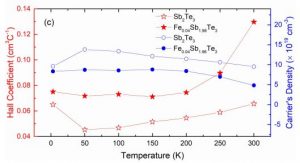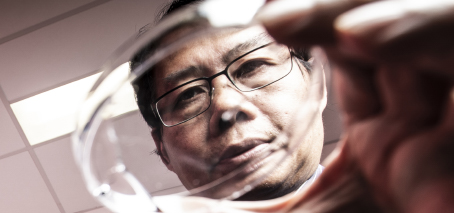 Iron-doping of the topological insulator Sb2Te3 results in useful electronic and magnetic properties, quantified in a recent FLEET study at the University of Wollongong.
Iron-doping of the topological insulator Sb2Te3 results in useful electronic and magnetic properties, quantified in a recent FLEET study at the University of Wollongong.
The researchers studied the magneto-transport properties of an iron-doped topological insulator (Fe–Sb2Te3).
After the material is doped via the addition of iron, its electronic structure changes significantly:
- multiple response frequencies emerge, in contrast to the single frequency detected for Sb2Te3 in its pure form
- carrier density and mobility is reduced.
“This improved understanding of the effects of doping on the topological insulator Sb2Te3 are critical to inform future possible use in low-energy electronics,” explains project leader Xiaolin Wang.
Background
Topological insulators (TIs) are novel materials that are neither electrical conductors, nor electrical insulators. Instead, a topological insulator is an insulator in its interior, but conducts along its edges (likened to a chocolate block wrapped in aluminium foil).
Topological insulators’ unique ‘Dirac’ surface states are attractive for electronic applications and potentially host a range of fascinating and useful phenomena.
In three-dimensional (3D) topological insulators such as Sb2Te3, the surface electronic structure is entangled with the internal (bulk) electronic structure and, consequently, both aspects need to be understood at the fundamental level.
Unresolved questions concerning the effect of metal doping of Sb2Te3 is related to one of the most fascinating transport properties in topological insulators: the quantum anomalous Hall effect (QAHE).
QAHE describes an effect that was once ‘unexpected’ (ie, ‘anomalous’): quantisation of the transverse ‘Hall’ resistance, accompanied by a considerable drop in longitudinal resistance.
It’s an area of great interest for technologists,” explains Xiaolin Wang. “They are interested in using this significant reduction in resistance to significantly reduce the power consumption in electronic devices.”
The study of magnetic-doped topological insulators seeks to find the optimal set of dopants, magnetic order, and transport properties in order to:
- Achieve a higher (near ambient) QAHE onset temperature
- Eliminate unwanted features in the electronic structure introduced by the transition-metal dopant that are detrimental to performance.
Findings in detail

FLEET AI Dr David Cortie and ARC DECRA, University of Wollongong
This new study reports the electronic effects of doping Sb2Te3 single crystals with iron, via magneto-transport experiments and complementary theoretical calculations.
Doping the topological insulator Sb2Te3 with iron results in:
The material’s electronic band structure changing significantly
- Introduction of multiple Fermi pockets, including two that are highly angle-dependent
- Reduced carrier density and mobility.
Using theoretical calculations, the researchers identified an additional bulk hole pocket introduced in the electronic structure, originating from chemical distortion associated with the iron dopant.
Two angle-dependent oscillation frequencies were identified, related to two Fermi pockets.
Moreover, the landscape of the electrons energy-momentum relationship changes via iron doping thus indicating a rich complexity in the underlying electronic structure.
Experimentally, both doped and undoped samples are hole-carrier dominated; however, iron doping also reduces the carrier density and mobility.
The study
The study Quantum oscillations in iron-doped single crystals of the topological insulator Sb2Te3 (DOI 10.1103/PhysRevB.99.165133) was published in Physical Review B in April this year.
This project was led by Prof Xiaolin Wang, who is the theme Leader of ARC Fleet Enabling technology A and the Director of ISEM at the University of Wollongong.
As well as funding by the Australian Research Council, the research benefitted from resources of Australia’s National Computational Infrastructure (NCI).
Novel materials at FLEET
 The properties of novel materials such as the topological insulator Sb2Te3 are studied at FLEET, an Australian Research Council Centre of Excellence, within the Centre’s Enabling technology A.
The properties of novel materials such as the topological insulator Sb2Te3 are studied at FLEET, an Australian Research Council Centre of Excellence, within the Centre’s Enabling technology A.
The Centre for Future Low-Energy Electronics Technologies (FLEET) is a collaboration of over a hundred researchers, seeking to develop ultra-low energy electronics to face the challenge of energy use in computation, which already consumes 8% of global electricity, and is doubling each decade.
Each of FLEET’s three research themes are heavily enabled by these novel materials, including 2D topological materials (Research Theme 1), atomically thin semiconductors (as hosts for excitons in Research Theme 2, and for realising non-equilibrium topological phenomena in Research Theme 3).
More information
- Contact Professor Xiaolin Wang xiaolin@uow.edu.au
- Connect at @FLEETCentre
- Visit FLEET.org.au
- Read FLEET Enabling technology A: novel materials news
- Contact FLEET media@FLEET.org.au
- Watch Future solutions to computation energy use
- Subscribe FLEET.org.au/news

FLEET PhD student Weiyao Zhao, University of Wollongong

FLEET AI Dr Zhi Li and ARC DECRA, University of Wollongong

FLEET Research Fellow Zengji Yue, University of Wollongong


